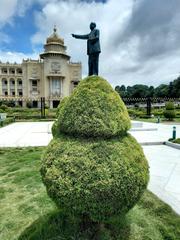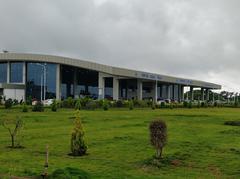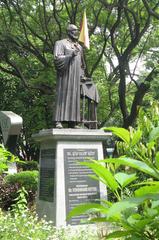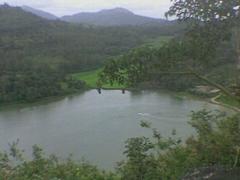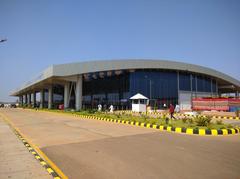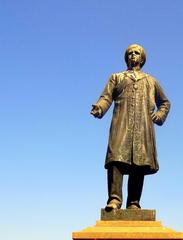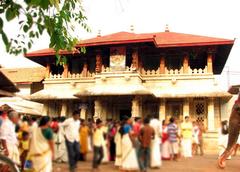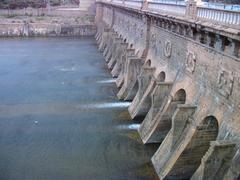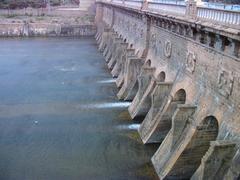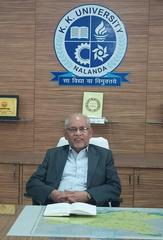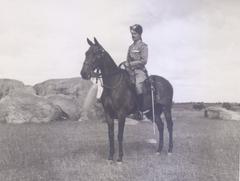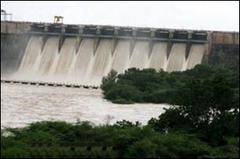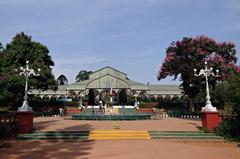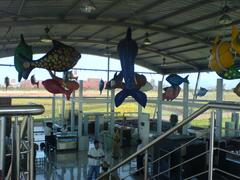
Siddhesvara Temple, Haveri, Karnataka: Comprehensive Visitor Guide
Date: 04/07/2025
Introduction
Nestled in the historic town of Haveri, Karnataka, the Siddhesvara Temple—also known as Purada Siddeshwara—stands as a remarkable testament to the Western Chalukya era’s rich cultural, religious, and architectural heritage. Dating back to the late 11th or early 12th century CE, this temple is renowned for its unusual westward orientation, intricate soapstone carvings, and a sculptural program featuring over 1,300 stone reliefs. Originally built under the patronage of the Western Chalukyas, the temple’s layered history reflects shifts from Vaishnavism to Jainism and ultimately Shaivism, mirroring the religious pluralism of the Deccan region. Today, Siddhesvara Temple remains a vibrant center for Shaivite worship, cultural activities, and historical exploration.
This guide provides a detailed overview of Siddhesvara Temple’s history, architecture, visiting hours, ticketing, accessibility, nearby attractions, and travel tips—designed to help you plan a meaningful visit to one of Karnataka’s most treasured historical sites.
For official resources and in-depth planning, refer to the Archaeological Survey of India Bengaluru Circle, Karnataka Tourism, and scholarly travel guides (Poojn.in).
Historical Overview and Dynastic Patronage
Constructed during the Western Chalukya (Kalyani Chalukya) period (c. 10th–12th centuries CE), Siddhesvara Temple was commissioned by local governors under the Chalukyan rulers, who were instrumental in the development of a distinctive architectural style bridging earlier Badami Chalukya and later Hoysala traditions (Karnataka Tourism). Inscriptions indicate that the temple was originally dedicated to Lord Shiva as Siddhesvara (the Perfected Lord), reflecting the Shaivite orientation of its patrons (Archaeological Survey of India).
Architectural Highlights
Layout and Unique Orientation
The temple showcases the Western Chalukya “Gadag style,” blending Dravidian and Nagara elements. Its most striking feature is its west-facing orientation—a rarity among Hindu temples, which typically face east (Wikipedia; Trawell.in). Visitors descend a few steps into a slightly sunken open mantapa (hall), a result of the structure settling over time (Trawell.in).
Construction Materials and Design
Built primarily from soapstone, the temple comprises a sanctum (garbhagriha), vestibule (antarala), and closed hall (navaranga/mantapa). Lathe-turned pillars support the mantapa, while decorative ceilings feature lotus and geometric motifs. The stepped pyramidal shikhara (superstructure) is quintessentially Chalukyan (Deccan Herald).
Sculptural Program
More restrained than later Hoysala temples, Siddhesvara Temple still boasts over 1,300 carvings, including:
- Shaivite Iconography: Shiva in meditation, Nandi, Ganapati, Nataraja, Ardhanarishvara, and Uma Maheshwara (Poojn.in).
- Other Deities: Vishnu with Lakshmi, Surya, Kartikeya, and serpent deities (Naga-Nagini) (Pravase).
- Entrance Reliefs: The Hindu trinity—Brahma, Vishnu, and Shiva—with Shiva prominent at the center.
Several old Kannada inscriptions from 1087 and 1108 CE provide valuable historical context (Epigraphia Carnatica).
Religious and Cultural Significance
Evolving Religious Identity
Siddhesvara Temple’s religious identity mirrors Karnataka’s dynamic spiritual history. Originally a Vaishnava shrine, it underwent Jain influences under Hoysala King Veera Ballala I and was later consecrated for Shaivite worship, which continues today (Hindu Temples of India; Poojn.in).
Rituals and Festivals
- Daily Rituals: Abhisheka (ritual bathing of the Shiva Linga), bilva leaf and rudraksha offerings, and regular poojas (Poojn.in).
- Major Festivals: Maha Shivaratri, Pradosha, Shravan Mondays, Ugadi, and Kannada Rajyotsava (Pilgrimaide).
During festivals, the temple hosts large gatherings, night-long vigils, and cultural programs, reinforcing its role as a regional religious and community center.
Cultural and Community Role
The temple serves as a hub for classical music, dance, religious discourses, and charitable activities, such as prasadam distribution and educational support (Poojn.in).
Visiting Hours, Tickets, and Practical Information
Timings and Entry
- General Timings: 6:00 AM to 6:00 PM (Pilgrimaide)
- Alternate Timings: 7:00 AM to 12:00 PM & 4:30 PM to 8:30 PM (Karnataka Explore)
- Official ASI Timings: 8:00 AM to 5:00 PM (Trawell.in)
- Entry Fee: Free for all visitors, including festival days (TravelTriangle)
Accessibility
The sunken basement requires descending steps, which may be difficult for visitors with mobility challenges. Elderly or disabled visitors should arrange for assistance in advance.
Dress Code and Etiquette
Visitors should wear conservative, clean clothing covering shoulders and knees. Footwear must be removed before entering. Photography is allowed in outer areas, but permission is required inside the sanctum.
Getting There
- Location: QCR6+773, Haveri Railway Station Rd, Netaji Nagar, Vidya Nagar, Haveri, Karnataka 581110 (TravelTriangle)
- Rail: 500 meters from Haveri Nagar Railway Station
- Road: 1.5 km from Haveri city center; 337 km from Bengaluru; 78 km from Hubli
- Air: Nearest airport is Hubli (approx. 80 km)
Local transport includes auto-rickshaws and taxis available from the railway station and bus stand.
Facilities and Nearby Attractions
Facilities
- Restrooms: Limited near the temple; use facilities at nearby hotels/restaurants.
- Food: Local vegetarian restaurants like Dhanush Restaurant, Kadamba Greens, and Chacha Restaurant (Pilgrimaide).
- Shops: Small stores and a supermarket nearby for snacks and essentials.
Best Times to Visit
October to March offers pleasant weather. Maha Shivaratri and Ugadi draw large crowds and provide vibrant cultural experiences.
Nearby Sites
- Mukteshwara Temple (Chaudayyadanapura): 44 km
- Tarakeshwara Temple (Hangal): 37 km
- Galageshwara Temple (Galaganath): 1.6 km
- Ranebennur Blackbuck Sanctuary: 36 km (TravelTriangle)
Travel Tips
- Arrive early to witness morning pooja and avoid crowds.
- Allocate 1–2 hours to explore the temple’s carvings and inscriptions.
- Dress modestly and carry water, especially during warmer months.
- Combine your visit with nearby temples or wildlife sanctuary for a fuller experience.
- Book accommodation in advance during festivals.
Frequently Asked Questions (FAQs)
Q: What are the Siddhesvara Temple’s visiting hours?
A: Timings range from 6:00 AM to 6:00 PM; confirm with local sources for festival days.
Q: Is there an entry fee?
A: No, entry is free for all visitors.
Q: Are guided tours available?
A: Official guided tours are rare, but local guides may be hired nearby.
Q: Is the temple accessible for people with disabilities?
A: Accessibility is limited due to steps and the sunken design.
Q: Is photography allowed?
A: Permitted in outer areas; seek permission for the sanctum or rituals.
Conclusion
Siddhesvara Temple in Haveri is a living monument of Western Chalukyan artistry, religious evolution, and enduring community significance. Its unique orientation, intricate carvings, and vibrant rituals offer an immersive journey into Karnataka’s medieval past. Whether you’re a history enthusiast, spiritual seeker, or cultural traveler, Siddhesvara Temple promises a rewarding experience.
For updated information and detailed planning, consult:
Download the Audiala app for comprehensive travel guides, maps, and festival updates. Follow us on social media for the latest posts, travel tips, and cultural insights into Karnataka’s heritage.
References
- Siddhesvara Temple Haveri: Visiting Hours, Tickets & Historical Guide, Karnataka Tourism
- Siddhesvara Temple, Haveri: Visiting Hours, Tickets, History & Cultural Significance, Poojn.in
- Siddhesvara Temple Haveri: Visiting Hours, Tickets & Architectural Highlights, Trawell.in
- Visitor Experience and Practical Tips for Siddhesvara Temple, Haveri, Karnataka Explore
- Archaeological Survey of India Bengaluru Circle
- Hindu Temples of India Blog
- Deccan Herald
- TravelTriangle
- Pilgrimaide
- Pravase
- Wikipedia
- Temple in Karnataka
- Epigraphia Carnatica
- Karnataka.com


